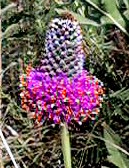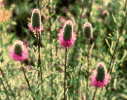
Purple Prairie Clover
Family: Legume
Size: 1 inch
Date: Late May

Purple Prairie Clover (Dalea purpureum)
Every county in North Dakota probably has a population of purple prairie clover. This is another of those species that are common and reach greatest abundance on the plains and prairies, but are occasionally encountered much further east on dry sites such as river bluffs, where environmental conditions similar to those of the interior grasslands occur.
The plant stands about a foot tall. About a half-dozen slender stems arise from a heavy perennial root crown. Each leaf is composed of five to seven tiny narrow leaflets arranged in pairs along a midrib. The flowering spikes are very distinctive, because a hundred or more tiny purple flowers are crowded to form a cylinder about a half-inch wide and one to two inches long.
Purple prairie clover is likely good forage for livestock as the plant decreases greatly in abundance under even moderate grazing intensity. Native Americans made tea from the leaves of purple prairieclover and used the roots for chewing. Amerindians in the western United States used other Daleas to dye skins and for remedies for coughs and colds. Others were used by the Kiowa because the tough, slender stems, tipped with cactus thorns, made good arrows for small game.
Daleas are members of the economically important bean family (Fabaceae) that includes our alfalfas, peas, clovers, peanuts, and trees such as caragana and locust. Fab means "bean" in Latin. The genus was named in honor of the distinguished English botanist Samuel Dale (1659-1739). There are about 200 species in the genus, mostly found in Mexico and the southwestern United States.
The specific epithet purpureum means "purple" in botanical Latin.Purple prairie clover was first described for science by the French botanist and horticulturist Etienne Ventenat (1757-1808).
![]()
 Wildflower
Seed For Sale
Wildflower
Seed For Sale